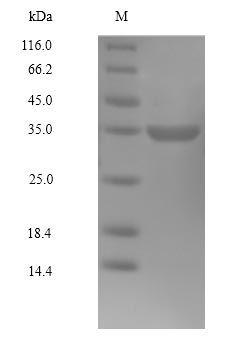The recombinant human CDK4 protein with an N-terminal 6xHis tag is expressed using a baculovirus expression system. The CDK4 gene fragment (2-303aa) is co-integrated into a vector with the 6xHis tag gene and then transformed into baculovirus. The baculovirus is cultured for protein expression by using IPTG. The recombinant CDK4 protein is isolated and purified by Ni-NTA affinity chromatography from the cell culture supernatant. The protein is analyzed by SDS-PAGE to determine purity, reaching up to 90%.
Human CDK4 is a crucial regulatory protein that plays a significant role in cell cycle progression, particularly in the transition from the G1 phase to the S phase. CDK4 functions by forming a complex with D-type cyclins, which is essential for its kinase activity. This interaction is tightly regulated by cyclin-dependent kinase inhibitors (CKIs) such as p16INK4a, which inhibit CDK4 activity and thereby control cell proliferation [1][2][3]. The phosphorylation of CDK4 at Thr172 is particularly important for its activation, allowing CDK4 to engage with cyclins effectively, thus promoting cell cycle progression [2][4].
The dysregulation of CDK4 is frequently observed in various cancers, where it contributes to unchecked cellular proliferation. Hyperactivation of the CDK4 pathway has been implicated in breast cancer, where elevated levels of cyclin D1 and CDK4 lead to enhanced tumor growth [5][6][7]. Furthermore, the presence of mutations in CDK4, such as R24C and R24H, has been associated with certain malignancies, although these mutations are not commonly found in sporadic endocrine tumors [1][4].
References:
[1] V. Vax, R. Bibi, S. Díaz‐Cano, M. Gueorguiev, B. Kola, N. Borboli, et al. Activating point mutations in cyclin-dependent kinase 4 are not seen in sporadic pituitary adenomas, insulinomas or leydig cell tumours, Journal of Endocrinology, vol. 178, no. 2, p. 301-310, 2003. https://doi.org/10.1677/joe.0.1780301
[2] L. Bockstaele, H. Kooken, F. Libert, S. Paternot, J. Dumont, Y. Launoit, et al. Regulated activating thr172 phosphorylation of cyclin-dependent kinase 4(cdk4): its relationship with cyclins and cdk “inhibitors”, Molecular and Cellular Biology, vol. 26, no. 13, p. 5070-5085, 2006. https://doi.org/10.1128/mcb.02006-05
[3] P. Roberts, J. Bisi, J. Strum, A. Combest, D. Darr, J. Usary, et al. Multiple roles of cyclin-dependent kinase 4/6 inhibitors in cancer therapy, Jnci Journal of the National Cancer Institute, vol. 104, no. 6, p. 476-487, 2012. https://doi.org/10.1093/jnci/djs002
[4] H. Yang, X. Zhao, L. Zhao, L. Liu, J. Li, W. Jia, et al. Prmt5 competitively binds to cdk4 to promote g1-s transition upon glucose induction in hepatocellular carcinoma, Oncotarget, vol. 7, no. 44, p. 72131-72147, 2016. https://doi.org/10.18632/oncotarget.12351
[5] E. Peurala, P. Koivunen, K. Haapasaari, R. Bloigu, & A. Jukkola-Vuorinen, The prognostic significance and value of cyclin d1, cdk4 and p16 in human breast cancer, Breast Cancer Research, vol. 15, no. 1, 2013. https://doi.org/10.1186/bcr3376
[6] Q. Yu, E. Sicińska, Y. Geng, M. Ahnström, A. Zagożdżon, Y. Kong, et al. Requirement for cdk4 kinase function in breast cancer, Cancer Cell, vol. 9, no. 1, p. 23-32, 2006. https://doi.org/10.1016/j.ccr.2005.12.012
[7] Y. Sun, D. Luo, & D. Liao, Cyclind1 protein plays different roles in modulating chemoresponses in mcf7 and mda-mb231 cells, Journal of Carcinogenesis, vol. 11, no. 1, p. 12, 2012. https://doi.org/10.4103/1477-3163.100401






